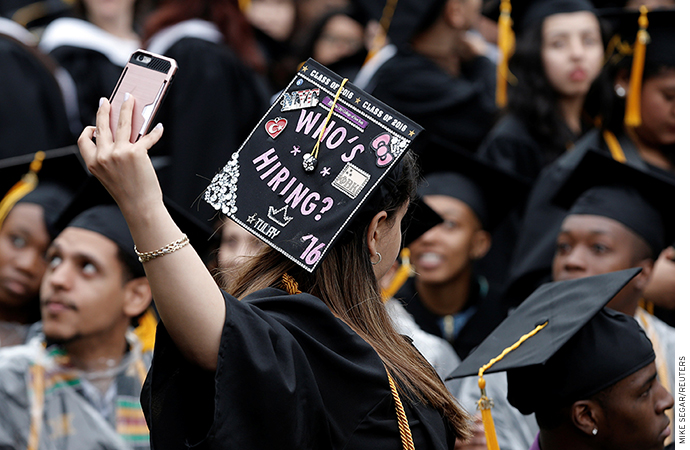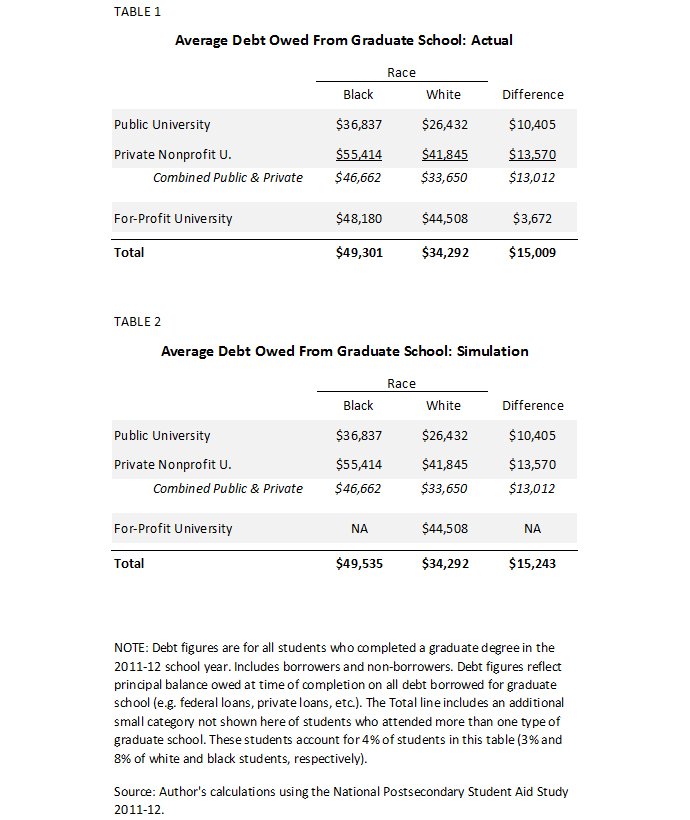
Discussions about higher education often focus on affordability—what college costs, what students pay and crucially, how much they borrow to finance their degrees. Discussions about student loans, however, rarely focus on what happens to the debt after students earn a college degree. That’s why a recent study by Columbia University professor Judith Scott-Clayton (a fellow Evidence Speaks contributor) and her co-author Jing Li is so important.
The researchers find that the difference in the amount of debt black and white undergraduates accumulate (“the black-white debt gap”) triples just four years after they leave school. Graduate school is a major factor in that trend. The number of black graduate students has been growing, and just like in undergraduate education, they borrow more than whites.
Li and Scott-Clayton also reveal that black students are much more likely to attend for-profit graduate schools and that much of the increase in graduate school enrollment among blacks in recent years has occurred at those schools. The Center for American Progress (CAP) published its own report on that topic and reached a similar conclusion.[i] Both reports warn that we have little information with which to judge the quality of graduate schools and programs.
Upon learning of this new research, many in the press were quick to draw a connection between the debt gap and for-profit graduate schools in particular. So quick, in fact, that they failed to check if there really was a meaningful connection.
Inside HigherEd claimed in the first sentence of its article on the research that the disparities in debt were “partly attributable to higher enrollment rates for black students in graduate programs, especially at for-profit institutions.” An Atlantic headline said the debt gap was, “tied in large part to the types of graduate schools people attend.”[ii] The Washington Post saw it the same way:
The Brookings Institution has linked the overrepresentation of African American students in these programs [for-profit graduate programs] to growing racial disparities in student debt, with black graduate students being twice as likely as whites to leave school with hefty loans.[iii]
The Li and Scott-Clayton study does indeed show that 1) the black-white debt gap is in large part due to greater graduate school enrollment and borrowing among blacks, and 2) blacks are much more likely to attend a for-profit graduate school, a sector in which black enrollment grew rapidly in recent years. That does not automatically mean, however, that 3) the black-white debt gap is exacerbated due to greater enrollment in for-profit graduate schools among blacks or that borrowing at for-profit graduate schools has a lower payoff than at other schools. In order to conclude 3, there must be an explanation and data that makes that case explicitly. Where is it?
Perhaps the explanation is that the debt gap would be smaller if the students who account for the enrollment growth in graduate school among blacks, many of whom attended for-profit universities, had opted not to go to graduate school at all. Those students would indeed have less debt in that case; they would also have less education. But why imply that black students would be better off not going to graduate school at all rather than a for-profit school if a lack of good data means we can’t determine which is the better choice? And why imply that when Li and Scott-Clayton cite research showing that the earnings boost from a graduate degree is larger for blacks than whites, a finding they say can’t be broken out by the type of school attended?[iv]
Maybe the media believes that for-profit enrollment and the debt gap are linked under the assumption that the debt gap would be smaller if black students who attended for-profit graduate schools attended other graduate schools instead. While that may be the case for undergraduates due to differences in what students pay at each type of school, it’s less likely to be the case for graduate students where grants, discounts, and subsidies to reduce tuition are negligible. Of course, we cannot know the counterfactual: the debt gap in a world where black students attend only public and private nonprofit graduate schools, but we can simulate that counterfactual using data on graduate school borrowing.
Simulating graduate school borrowing
The U.S. Department of Education’s National Postsecondary Student Aid Study for the 2011-12 academic year (the most recent survey) includes data on how much graduate students borrow broken out by race and type of school.[v] Based on these data, the black-white debt gap (graduate school debt only) is $15,009 among students who completed a graduate degree at any type of school in the 2011-12 academic year. In other words, black students left graduate school with an average of $15,009 more in debt borrowed to finance that education than white students did (see Table 1).[vi]
Using the same data, we can simulate what the debt gap might be if the black students who attended for-profit graduate schools instead went to private nonprofit and public universities. To do this, we simply exclude all of the black students who attended for-profit colleges from the comparison and assume that they attended other graduate schools instead. (Remember, if they opt not to go at all, then the debt gap is guaranteed to be lower.)
We take the assumption another step and presume that those students enrolled in the alternate schools at rates that match the enrollment split of black students who actually attended public and private nonprofit universities. A different simulation might assume that the students at for-profit schools all attend private nonprofit universities instead, or that they all attend public universities instead. But keeping the enrollment mix between the two university types in line with actual enrollment patterns establishes a base case scenario and is the most straightforward assumption. Finally, this approach assumes that the additional black students who hypothetically attend public and private nonprofit graduate schools exhibit the same borrowing patterns as the black students who actually attended those schools. Without changing anything else in the data, those assumptions allow us to zero out black enrollment at for-profit graduate schools and then examine how the black-white debt gap is affected.
The hypothesis is that the debt gap will be smaller under this simulation than in reality. Yet the debt gap comes in at $15,243 under the simulation, effectively unchanged from reality. The $234 difference is too small to be statistically significant (see Table 2).

Why doesn’t the debt gap shrink when we assume students who go to for-profit colleges instead enroll at other schools? Because black students who attend for-profit graduate schools do not accumulate more debt than black students attending other graduate schools. The former group owes $48,180 and the latter group owes $46,662; the difference between the two numbers is not statistically significant (see Table 1).
Yes, black students who earn graduate degrees from public universities borrow less than their peers at for-profit schools, but the black students who earn graduate degrees from private nonprofit schools rack up even more debt than their for-profit-going peers, leaving with $55,414 on average (see Table 1).[vii] Thus, the average per-student debt of the combined group of black students attending public and private nonprofit graduate schools is not larger than the per-student debt of the group attending for-profit graduate schools.
Conclusion and policy implications
It’s important for policymakers to know that graduate school enrollment is exacerbating the black-white debt gap, but there is at best a weak case for calling out for-profit schools in that trend. If those schools were to merit a special mention regarding the debt gap, researchers and the media should be able to show that students who attended for-profit schools accumulated more debt than if they had attended a different type of school, or that a graduate degree from a for-profit school has a lower return on investment than one from another school. They haven’t attempted to make either case.
That is the lesson for policymakers in this debate. The U.S. Department of Education’s College Scorecard, which provides limited information about the earnings of students who attended colleges or universities, excludes graduate schools.[viii] It is a glaring omission given that black and white students alike are borrowing over $30,000 to finance those degrees. Better information about graduate student outcomes would allow students, researchers, and the media to know whether borrowing more at one type of school might actually be a better investment than borrowing less or the same amount at another.
Without that information, many in the policy community will make the unjustified assumption that “for-profit” is synonymous with “bad bet” when it comes to graduate school.
— Jason D. Delisle
Jason D. Delisle is a resident fellow at the American Enterprise Institute (AEI), where he works on higher education financing with an emphasis on student loan programs.
This post originally appeared as part of Evidence Speaks, a weekly series of reports and notes by a standing panel of researchers under the editorship of Russ Whitehurst.
The author(s) were not paid by any entity outside of Brookings to write this particular article and did not receive financial support from or serve in a leadership position with any entity whose political or financial interests could be affected by this article.
Notes:
[i] Elizabeth Baylor, “The Unlikely Area in Which For-Profit Colleges Are Doing Just Fine, Center for American Progress, December 1, 2016, www.americanprogress.org/issues/education/news/2016/12/01/291656/the-unlikely-area-in-which-for-profit-colleges-are-doing-just-fine/.
[ii] Andrew Kreighbaum, “Growing Racial Disparities in Student Debt, Inside HigherEd, October 21, 2016, www.insidehighered.com/news/2016/10/21/brookings-study-finds-growing-disparities-student-loan-debt-between-black-and-white; Emily Deruy, “The Racial Disparity of the Student-Loan Crisis: The answer seems to be tied in large part to the types of graduate schools people attend,” The Atlantic, October 24, 2016, www.theatlantic.com/education/archive/2016/10/why-debt-balloons-after-graduation-for-black-students/505058/.
[iii] Danielle Douglas-Gabriel, “The Surprising Growth of Graduate Enrollment at For-Profit Colleges,” Washington Post, December 1, 2016, www.washingtonpost.com/news/grade-point/wp/2016/12/01/the-surprising-growth-of-graduate-enrollment-at-for-profit-colleges/?tid=ss_tw&utm_term=.413188014306.
[iv] Scott-Clayton and Li, Black-White Disparity in Student Loan Debt More than Triples After Graduation.
[v] This is different data than the longitudinal dataset than what Li and Scott-Clayton use (the U.S. Department of Education’s Baccalaureate and Beyond 2007-08 survey data, 2012 follow up), but they are related datasets. The Baccalaureate and Beyond data is drawn from students who participate in the NPSAS and the follow up year for Baccalaureate and Beyond is the same year covered by the NPSAS used in this paper.
[vi] Debt figures are for all students who completed a graduate degree in the 2011-12 school year. Includes borrowers and non-borrowers. Debt figures reflect the average principal balance owed at time of completion on all debt borrowed for graduate school (e.g., federal loans, private loans, etc.). The Total line includes an additional small category not shown here of students who attended more than one type of graduate school. These students account for 4 percent of students in this table (3 percent and 8 percent of white and black students, respectively). The findings in this paper are not affected by including or excluding this small group. The variables in the NPSAS dataset used for the analysis are SECTOR4 (the type of graduate school), OWEAMT2 (the principal balance owed on all graduate school debt), RACE (student race), and PROGSTAT (whether the student complete the degree in the 2011-12 school, the year the survey was administered). I tested the sensitivity of the results in the survey using different debt variables in the NPSAS and different points in graduate students’ progressions toward their degrees (i.e., debt in the first year, second year, upon completion) and did not find that the different variables affected my overall findings and conclusions.
[vii] About as many black students attend graduate schools at private nonprofit universities as the number of blacks who attend graduate schools at public universities.
[viii] U.S. Department of Education, “College Scorecard,” https://collegescorecard.ed.gov/.



